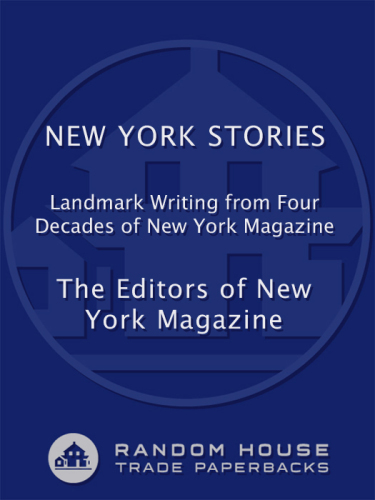
New York Stories
Landmark Writing from Four Decades of New York Magazine
کتاب های مرتبط
- اطلاعات
- نقد و بررسی
- دیدگاه کاربران
نقد و بررسی

September 15, 2008
In a delightful foreword, Tom Wolfe hits the ground running with a chronicle of New York Magazine's humble beginnings, as a supplement to The New York Herald Tribune, and its growth, at the hands of fearless editor Clay Felker, to rival the untouchable New Yorker. For the mag's 40th anniversary, the editors have collected some of its most memorable essays, including Mark Jacobsen's 1975 "Night-Shifting for the Hip Fleet" (which loosely inspired the television show Taxi, Nik Cohn's Tribal Rights of the New Saturday Night and, in turn, the film Saturday Night Fever), two Gloria Steinem essays (including her brilliant 1969 manifesto, "After Black Power, Women's Lib"), and other articles from the likes of Jay McInerney, George Plimpton, Nora Ephron, Joe Klein, and current New York regulars Kurt Anderson and Emily Nussbaum. More recent favorites include Steve Fishman's "The Dead Wives Club, or Char in Love," about a group profile of Staten Island firemen's wives widowed on 9/11, and Mark Jacobson's "The $2,000-an-Hour Woman," a 2005 piece on "America's No. 1 escort" (whose colleague would later bring down Gov. Eliot Spitzer). Highlights abound, including Wolfe's classic 1976 "The 'Me' Decade," which details the yuppy phenomenon's "great religious wave" of narcissistic self-discovery for "dreary little bastards" with money. A pleasure to read, this book will satisfy anyone wishing to reminisce about New York City and the birth of New Journalism.

October 15, 2008
To celebrate its 40th anniversary, "New York" magazine editors Fishman, Adam Moss, and John Homans present the most thought-provoking and culturally influential articles from the past four decades of the magazine. Founded by Clay Felker in 1968, the magazine highlighted life, culture, and politics in New York City and later included American society at large. Felker strived to compete with the prestigious "New Yorker" as the purveyor of ideas and culture among the Manhattan literati. More edgy and hip than its competitor, "New York" featured the writings of such notables as Gloria Steinem, Gail Sheehy, and Tom Wolfe. Its influence on popular culture is evident in several selections in this anthology. Nicholas Pileggi's "Wiseguy" and Nik Cohn's "Tribal Rites of the New Saturday Night" became the groundbreaking films "Goodfellas" and "Saturday Night Fever", respectively. This is not just a collection of great stories from the past 40 years; it is a study of the historical and sociological ideas and events that shaped the nation during that time. Highly recommended, especially for larger public libraries and academic libraries.Donna Marie Smith, Palm Beach Cty. Lib. Syst., FL
Copyright 2008 Library Journal, LLC Used with permission.

November 1, 2008
From its birth as a Sunday newspaper supplement, New York magazine has incubated many of the nations best writers, its influence on journalism and literature far exceeding its size and circulation. Virtually inventing the new journalism of the late twentieth century, New York has consistently courted both innovation and controversy and appeals to an audience well beyond its metropolitan base. This anthology brings together representative examples of the magazines prose. Cultural issues include Gael Greene on pretentious restaurants, Julie Baumgold on Truman Capotes last days, and Vanessa Grigoriadis on bloggers. The magazines political pundits couldnt be more stellar: Gloria Steinem, Garry Wills, David Halberstam, and Richard Reeves, profiling national leaders from Nixon through Obama. Tom Wolfe contributes a foreword that succinctly captures founding editor Clay Felkers charisma and talent as well as his magazines perennial sniping feud withthe New Yorkers William Shawn.(Reprinted with permission of Booklist, copyright 2008, American Library Association.)

























دیدگاه کاربران